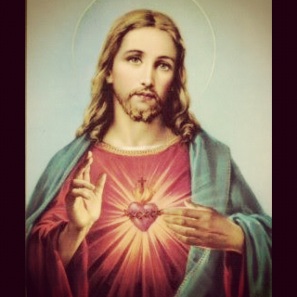
So, besides the fact that I simply like ancient and mediaeval Christianity (theologically, devotionally, artistically, liturgically, musically), one of the themes running through this blog is the use of our ancient and mediaeval inheritance to untame God and draw nearer to Him. Certainly my own time with the Church Fathers has helped untame my vision of God. The Fathers and monks and mystics of 2000 years of Church history have saved me from a small faith and weak theology.
In response to my post about mediaeval and Renaissance representations of Jesus as white, a friend said that most people aren’t necessarily concerned with those older representations but, rather, with the flannelgraph Jesus we all grew up with where He is so clearly just one of us white dudes in a robe. Not unlike my father.*
This comment made me think about contemporary representations of Jesus, especially in white congregations. While I think blond, Germanic Jesuses of the Early Middle Ages, or Chinese Jesuses in the 19th century, or mediaeval Jesuses who like vaguely like Buddha (also in China), or First Nations Jesuses today, maybe the time for such encultured Jesuses in white churches is over.
I’m not concerned with ‘imperialism’ or ‘racism’ here. I’m more concerned with tameness. With ‘gentle Jesus, meek and mild.’
Do our ongoing white Jesuses serve to tame the untamable? Have we made Jesus too normal? Have we lost the shock and scandal and bewilderment of the historical particularity of the Incarnation? Yes, God became one of us. And that meant a first-century Palestinian working-class Jewish guy.
That is to say, perhaps the time for this 19th-c image of the Sacred Heart of Jesus, whence comes flannelgraph Jesus, I believe, has gone:

But I don’t think the BBC’s 2001 image of Jesus should ever have its day. Not because it’s untraditional but because it’s creepy. A friend of mine says that there is a stage at which computer images move from acceptable to creepy as they become more real. Like the trailers for the new Tarzan film (which I eschew on principle). I’ve seen these facial reconstructions done by osteoarchaeologists and forensic scientists before, for Pompeiians and Bog People and they are always creepy.
When I say I want Jesus to be ‘weird’, I mean I want him to be less familiar, not more creepy.
Perhaps then we can begin to be shocked anew at the sayings of the Crucified God. Perhaps we can realise that He spends a lot of time challenging our lifestyles, and that’s really uncomfortable. Perhaps.
Perhaps we can untame our theology and be seized again by the power of the Triune God who is completely beyond our understanding.
*Who has been referred to as ‘God’ by children on multiple occasions. The beard and the robes …

This post reminded me of this lecture by Matthew Milliner (possibly the only evangelical Byzantine art historian. . . as far as I know 😉 ): Seeing Icons With Protestant Eyes (http://youtu.be/S9Q0_uCyWLY).
Also, he previously gave a related lecture that you also might like: Visual Heresy: Imaging God the Father in the History of Art (http://youtu.be/JdaBe0dFsTI).
Groovy. Now I know how to spend my Sunday afternoon. 😉
Is it the whiteness of Jesus that makes him seem “tame” (and is that simply because it is more culturally familiar)? So that the exotic/faraway/different naturally strikes one as less tame? Or is it really the posture/pose – the gentle face, the greeting-card-style Jesus, etc. that seems to overemphasize a “my pal” sort of informality that seems not to honor His majesty and suffering?
One convent I go to has a Sacred Heart statue where Jesus seems to be shrugging his shoulders, as if helpless or confused. I’m more a fan of the gory life-sized crucifix at another church, or the stern depiction of Christ as teacher in the icon I have on my desk.
Maybe it’s the whole package! Perhaps a Middle Eastern flannelgraph Jesus or Sacred Heart would be as ‘tame’ to us as the white ones. This is a good point.
I prefer big, bloody crucifixes over the Sacred Heart, as well. In Almost Catholic, Jon Sweeney says that the first thing anyone should do on becoming a Catholic — before buying a Catholic Bible or a liturgy — is get a large, bloody crucifix and hang it somewhere in the home!
For instance: http://static.tumblr.com/f23e6bb7b00da7c97eba1ca1feb57a9a/oj3gkfc/e3Jmqphiz/tumblr_static_blackjesuschildren-t.jpg
🙂
That’s about as tame as Jesus gets, right there!